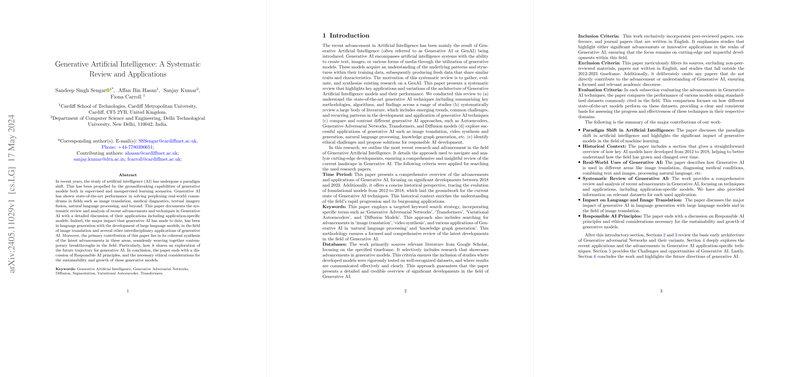Generative Artificial Intelligence: A Systematic Review and Applications
Overview
The paper "Generative Artificial Intelligence: A Systematic Review and Applications" co-authored by Sandeep Singh Sengar, Affan Bin Hasan, Sanjay Kumar, and Fiona Carroll presents a meticulous exploration of the advancements and application-specific models within the domain of Generative AI (GenAI). This comprehensive review is scoped between the years 2018 and 2023, offering a detailed historical context that traces the evolution from foundational models developed between 2012 and 2018. The review is systematically conducted and meticulously documents the impacts, challenges, opportunities, and ethical considerations surrounding Generative AI.
Key Contributions
1. Paradigm Shift in AI and Historical Context:
The paper discusses the shift in AI propelled by generative models capable of unsupervised and supervised learning. A historical progression is provided, elucidating the development of key AI models from 2012 to 2018, which laid the foundational groundwork for contemporary GenAI techniques.
2. Applications in Image Translation:
Among the pivotal applications of Generative AI, image translation stands out prominently. For example, the usage of GAN-based models has revolutionized medical diagnostics and image synthesis. Methods like SwinTransformer, CycleGAN, and Pix2Pix GAN demonstrate substantial advancements in translating medical imaging modalities, improving diagnostic precision through high-quality image synthesis. Pairing traditional GANs with novel architectures like Swin Transformers has yielded state-of-the-art performance in translating MRI images from T1 to T2 modes, as exemplified by results on the BraTs2018 dataset.
3. Video Synthesis and Generation:
Generative AI also significantly impacts video synthesis and generation techniques, including the creation of realistic talking head videos using Depth-Aware GANs and DaGAN++. Innovations such as StyleTalker facilitate highly accurate lip synchronization and realistic head poses in video generation from audio inputs, underpinning advancements in video conferencing, virtual reality, and entertainment industries.
4. Natural Language Processing:
The paper provides a detailed review of transformative progress in NLP driven by models such as BERT, T5, and StyleTalker. Particularly, BERT's performance in tasks like Named Entity Recognition (NER) surpasses previous methodologies. Multilingual model evaluations underscore BERT's robustness across languages, showcasing significant advancements in machine translation, language generation, and educational applications, where models like ChatGPT exhibit impressive question-answering capabilities.
5. Knowledge Graph Generation:
The synthesis and enhancement of knowledge graphs are significantly boosted by Generative AI. Techniques like KBGAN and K-BERT integrate commonsense and domain-specific knowledge to improve the quality and depth of knowledge graphs. Models like TuckER and ComplexGCN further advance link prediction tasks, demonstrating superior performance in structuring and querying rich datasets.
6. Interdisciplinary Applications and Ethical Considerations:
The paper explores the interdisciplinary applications of GenAI in fields such as mechanical fault detection and traffic scenario generation, emphasizing its potential for substantial practical impact. It highlights the ethical implications and need for responsible AI development, discussing frameworks for mitigating biases, ensuring data privacy, and implementing transparency in AI-generated content.
Implications of the Research
Practical Implications:
The advancements in Generative AI facilitate diverse practical applications across medical imaging, video generation, automated content creation, and personalized learning systems, among others. These innovations promise to enhance productivity, improve diagnostic accuracy, and provide more effective educational tools.
Theoretical Implications and Future Directions:
Theoretically, the development of robust and versatile generative models drives forward the understanding of both deep learning architectures and AI application frameworks. Future research directions should focus on further refining model architectures to address current limitations in interpretability, robustness against adversarial attacks, and ethical governance. Additionally, interdisciplinary collaborations and real-world implementations will be pivotal in uncovering new applications and improving existing ones.
Conclusion
The paper delivers a thorough and insightful review of Generative AI, showcasing the extensive impacts and diverse applications of generative models across multiple domains. By documenting the advancements, challenges, and opportunities, the paper paves the way for future research and development in this rapidly evolving field. Emphasizing the necessity for responsible AI principles, ethical considerations, and continuous innovation, the paper reflects a balanced approach towards harnessing the transformative potential of Generative AI.
